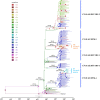Cross-Continental Dispersal of Major HIV-1 CRF01_AE Clusters in China
- PMID: 32082287
- PMCID: PMC7005055
- DOI: 10.3389/fmicb.2020.00061
Cross-Continental Dispersal of Major HIV-1 CRF01_AE Clusters in China
Abstract
Since the 1990s, several distinct clusters of human immunodeficiency virus-type 1 (HIV-1) CRF01_AE related to a large epidemic in China have been identified, but it is yet poorly understood whether its transmission has dispersed globally. We aimed to characterize and quantify the genetic relationship of HIV-1 CRF01_AEs circulating in China and other countries. Using representative sequences of Chinese clusters as queries, all relevant CRF01_AE pol sequences in two large databases (the Los Alamos HIV sequence database and the UK HIV Drug Resistance Database) were selected with the online basic local alignment search (BLAST) tool. Phylogenetic and phylogeographic analyses were then carried out to characterize possible linkage of CRF01_AE strains between China and the rest of the world. We identified that 269 strains isolated in other parts of the world were associated with five major Chinese CRF01_AE clusters. 80.7% were located within CN.01AE.HST/IDU-2, most of which were born in Southeast Asia. 17.8% were clustered with CN.01AE.MSM-4 and -5. Two distinct sub-clusters associated with Chinese men who have sex with men (MSM) emerged in HK-United Kingdom and Japan after 2000. Our analysis suggests that HIV-1 CRF01_AE strains related to viral transmission in China were initially brought to the United Kingdom or other countries during the 1990s by Asian immigrants or returning international tourists from Southeast Asia, and then after having circulated among MSM in China for several years, these Chinese strains dispersed outside again, possibly through MSM network. This study provided evidence of regional and global dispersal of Chinese CRF01_AE strains. It would also help understand the global landscape of HIV epidemic associated with CRF01_AE transmission and highlight the need for further international collaborative study in this field.
Keywords: CRF01_AE; China; HIV-1; cross-continental; dispersal.
Copyright © 2020 An, Han, Zhao, English, Frost, Zhang and Shang.
Figures




Similar articles
-
Phylodynamics of major CRF01_AE epidemic clusters circulating in mainland of China.Sci Rep. 2017 Jul 24;7(1):6330. doi: 10.1038/s41598-017-06573-6. Sci Rep. 2017. PMID: 28740095 Free PMC article.
-
Molecular epidemiological study of HIV-1 CRF01_AE transmission in Hong Kong.J Acquir Immune Defic Syndr. 2009 Aug 15;51(5):530-5. doi: 10.1097/QAI.0b013e3181aac516. J Acquir Immune Defic Syndr. 2009. PMID: 19521252
-
The Epidemic Dynamics of Four Major Lineages of HIV-1 CRF01_AE Strains After Their Introduction into China.AIDS Res Hum Retroviruses. 2016 May;32(5):420-6. doi: 10.1089/AID.2015.0212. Epub 2016 Mar 16. AIDS Res Hum Retroviruses. 2016. PMID: 26830205
-
The rapidly expanding CRF01_AE epidemic in China is driven by multiple lineages of HIV-1 viruses introduced in the 1990s.AIDS. 2013 Jul 17;27(11):1793-802. doi: 10.1097/QAD.0b013e328360db2d. AIDS. 2013. PMID: 23807275 Free PMC article.
-
[Analysis on gene sequence of HIV isolated from men who have sex with men in Beijing].Zhonghua Liu Xing Bing Xue Za Zhi. 2015 Sep;36(9):988-93. Zhonghua Liu Xing Bing Xue Za Zhi. 2015. PMID: 26814868 Chinese.
Cited by
-
Dispersion and diversification of Lyssavirus rabies transmitted from haematophagous bats Desmodus rotundus: a phylogeographical study.Virus Genes. 2023 Dec;59(6):817-822. doi: 10.1007/s11262-023-02030-x. Epub 2023 Oct 5. Virus Genes. 2023. PMID: 37796410
-
Genetic characterization of a novel HIV‑1 CRF01_AE/ CRF07_BC recombinant form found among men who have sex with men in Baoding City, Hebei Province, China.Arch Virol. 2022 Nov;167(11):2395-2402. doi: 10.1007/s00705-022-05563-y. Epub 2022 Aug 9. Arch Virol. 2022. PMID: 35945380 Free PMC article.
-
Identification of a New HIV-1 Circulating Recombinant Form CRF112_01B Strain in Baoding City, Hebei Province, China.Curr HIV Res. 2022;20(6):485-491. doi: 10.2174/1570162X21666221027122528. Curr HIV Res. 2022. PMID: 36305139
-
Challenges in Elucidating HIV-1 Genetic Diversity in the Middle East and North Africa: A Review Based on a Systematic Search.Viruses. 2025 Feb 27;17(3):336. doi: 10.3390/v17030336. Viruses. 2025. PMID: 40143265 Free PMC article.
-
Distinct genetic clusters in HIV-1 CRF01_AE-infected patients induced variable degrees of CD4+ T-cell loss.mBio. 2024 Mar 13;15(3):e0334923. doi: 10.1128/mbio.03349-23. Epub 2024 Feb 22. mBio. 2024. PMID: 38385695 Free PMC article.
References
-
- Angelis K., Albert J., Mamais I., Magiorkinis G., Hatzakis A., Hamouda O. (2015). Global dispersal pattern of HIV Type 1 Subtype CRF01_AE: a genetic trace of human mobility related to heterosexual sexual activities centralized in Southeast Asia. J. Infect. Dis. 211 1735–1744. 10.1093/infdis/jiu666 - DOI - PubMed
-
- Cuevas M., Fernandez-Garcia A., Sanchez-Garcia A., Gonzalez-Galeano M., Pinilla M., Sanchez-Martinez M. (2009). Incidence of non-B subtypes of HIV-1 in Galicia, Spain: high frequency and diversity of HIV-1 among men who have sex with men. Euro. Surveill. 14:19413. - PubMed
LinkOut - more resources
Full Text Sources
Research Materials

